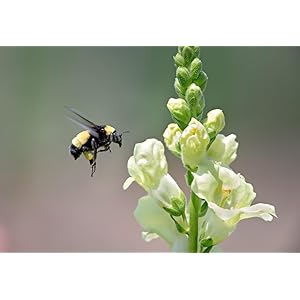Vegetables Love Flowers: Companion Planting for Beauty and Bounty
$19.50

Price: $19.50
(as of Oct 13, 2022 02:35:28 UTC – Details)
TABLE OF CONTENTS








Section 1 . Flowers in the Vegetable Garden
Chapter 1. Why Do Vegetables Love Flowers?
Chapter 2 . How to Interplant Your Vegetable Patch.
Chapter 3 . The Cutting Garden.
Section 2. Plants By Season
Chapter 4 . Warm-Season Tender Annuals.
Chapter 5 . Cool-Season Hardy Annuals.
Section 3. Heroes of the Garden
Chapter 6 . Pollinators.
Chapter 7 . Beneficial Predators.
Section 4. Growing A Healthy Garden
Chapter 8 . Tending the Healthy Garden.
Chapter 9 . The Yard around the Garden.


Adding Flowers
The best dose of medicine my gardens ever received were flowers. Looking back, it was a perfect storm of circumstances that unfolded and ushered me into flower farming: my beginner’s success growing vegetables, the light-bulb moment on how nature could help my garden, and those stacks of empty bags. And all the while, I was putting my dream into reality—growing flowers as my chosen work.
I launched into growing cut flowers to sell in 1998 and was met with the same growing success as I had had with vegetables. Everything I planted grew like mad. At first I added a bed or two of flowers within our large vegetable gardens, and then as the demand and my business grew, I became a full-time urban flower farmer. During this time, my gardens grew from two ¼-acre gardens to also include an additional 1-acre garden.
It didn’t take long for my gardens to start filling up with some obvious good things beyond the flowers I was now planting. As soon as the blooms began, it seemed that butterflies, bees, and birds were everywhere. There among the flowers were creatures buzzing and flitting around just like you imagine nature at its best.
I grew zinnias, sunflowers, snapdragons, sweet peas, and other popular cut flowers. They were much more than just pretty faces—they provided food and habitat for beneficials. While there are flowers that are especially attractive to specific groups of beneficial insects, the bottom line is just is to grow flowers—any flowers!


Bumblebees and Tomatoes
What do bumblebees offer tomatoes that other bees don’t? Buzz pollination. Tomato blooms have all the necessary parts to self-pollinate, so to get that process moving, either wind needs to knock the pollen loose or a bumblebee can visit and do the job. The bumblebee reaches in and grabs the anther with its jaws and vibrates its wings. This action forcibly expels pollen out, where it would have been otherwise trapped.
Bumblebees are essential to strong tomato pollination. Snapdragons, a favorite of bumblebees, attract them to the garden just in time to visit the tomato blooms.


When Should I Plant?
This family of plants likes to start life in the garden when the soil and air temperatures are warm to hot. Once the last expected spring frost date has passed and nighttime temperatures are staying consistently above 60 degrees Fahrenheit with summer drawing near, it is time to plant. A common mistake is to plant too early, when the soil and air may still be chilly. Plants that survive this blunder will get off to a slower start and can suffer consequences the rest of the season. The best opportunity for plants to grow a deep and healthy root system is when they’re planted into their preferred planting time. They love warm soil and air temperatures and will reward you when that is given. Once well established, these plants can face the heat and humidity of summer with little intervention.


Organic Fertilizers
We use dry and liquid organic fertilizers. For watering transplants, add organic liquid fertilizer to the watering can once a week per product instructions. When preparing the planting bed, incorporate dry organic fertilizer into the soil per product instructions. Plants will really appreciate a monthly soil drench with the liquid fertilizer and a foliar feeding once planted in the garden. A soil drench is pouring liquid fertilizer mix onto the soil or running it through an irrigation system. Foliar feeding is to sprinkle or spray the liquid fertilizer mix on the leaves. I stop foliar feeding when buds or fruit begin to form because the fertilizer is aromatic, and you won’t want your cut flowers or vegetables to have this smell. I like to use fertilizers that are made from sustainable products such as seaweed, fish, and chicken litter.
Leaf litter is always the preferred mulch in my garden pathways. It adds tons of organic matter, retains moisture, and harbors beneficial creatures.
Publisher : Cool Springs Press; Illustrated edition (March 27, 2018)
Language : English
Paperback : 176 pages
ISBN-10 : 0760357587
ISBN-13 : 978-0760357583
Item Weight : 1.1 pounds
Dimensions : 7.75 x 0.5 x 9.25 inches







